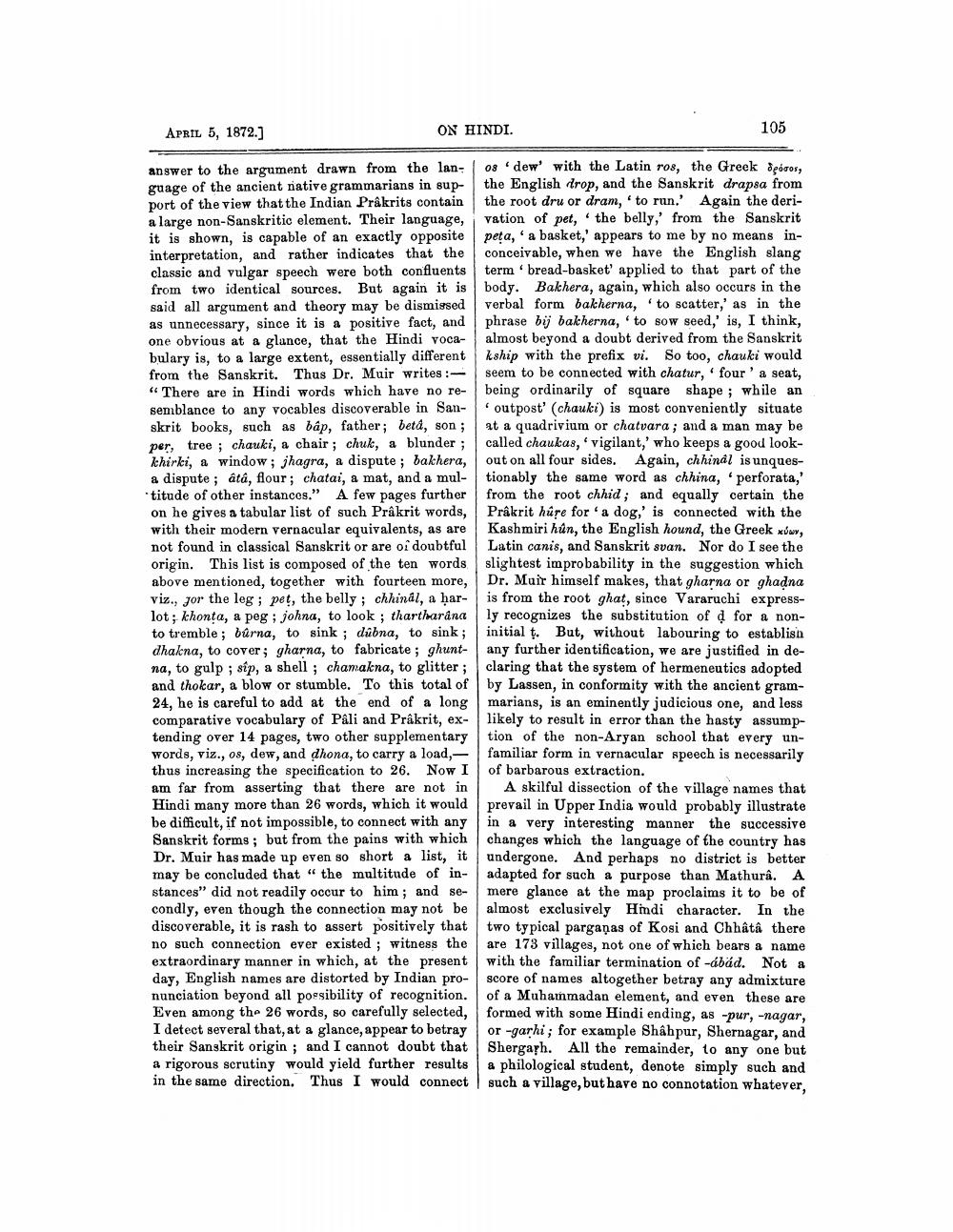________________
APRIL 5, 1872.]
ON HINDI.
105
answer to the argument drawn from the lan- 08 dew with the Latin ros, the Greek dpóros, guage of the ancient rative grammarians in sup- the English drop, and the Sanskrit drapsa from port of the view that the Indian Prakrits contain the root dru or dram, to run.' Again the deria large non-Sanskritic element. Their language, i vation of pet, the belly,' from the Sanskrit it is shown, is capable of an exactly opposite peta, a basket,' appears to me by no means ininterpretation, and rather indicates that the conceivable, when we have the English slang classic and vulgar speech were both confluents term bread-basket' applied to that part of the from two identical sources. But again it is body. Bakhera, again, which also occurs in the said all argument and theory may be dismissed verbal form bakherna, 'to scatter,' as in the as unnecessary, since it is a positive fact, and phrase bij bakherna, 'to sow seed,' is, I think, one obvious at a glance, that the Hindi voca- almost beyond a doubt derived from the Sanskrit bulary is, to a large extent, essentially different kship with the prefix vi. So too, chauki would from the Sanskrit. Thus Dr. Muir writes :- seem to be connected with chatur, four' a seat, “There are in Hindi words which have no re- being ordinarily of square shape ; while an semblance to any vocables discoverable in San- outpost' (chauki) is most conveniently situate skrit books, such as bâp, father; betd, son ; at a quadrivium or chatvara; and a man may be per, tree ; chauki, a chair; chuk, a blunder ; called chaukas, vigilant,' who keeps a good lookkhirki, a window; jhagra, a dispute ; bakhera, out on all four sides. Again, chhinal is unquesa dispute ; atá, flour; chatai, a mat, and a mul- tionably the same word as chhina, perforata,' titude of other instances." A few pages further from the root chhid ; and equally certain the on he gives a tabular list of such Prakrit words, Prakrit høre for a dog,' is connected with the with their modern vernacular equivalents, as are Kashmiri hún, the English hound, the Greek xów, not found in classical Sanskrit or are o doubtful Latin canis, and Sanskrit svan. Nor do I see the origin. This list is composed of the ten words slightest improbability in the suggestion which above mentioned, together with fourteen more, Dr. Muir himself makes, that gharna or ghadna viz., for the leg ; pet, the belly; chhinal, a har- is from the root ghat, since Vararuchi expresslot; khonta, a peg; johna, to look ; thartharana ly recognizes the substitution of d for a nonto tremble; búrna, to sink ; dubna, to sink; initial ţ. But, without labouring to establish dhakna, to cover; gharna, to fabricate ; ghunt- any further identification, we are justified in dena, to gulp ; síp, a shell ; chamakna, to glitter; claring that the system of hermeneutics adopted and thokar, a blow or stumble. To this total of by Lassen, in conformity with the ancient gram24, he is careful to add at the end of a long marians, is an eminently judicious one, and less comparative vocabulary of Páli and Prakrit, ex- likely to result in error than the hasty assumptending over 14 pages, two other supplementary tion of the non-Aryan school that every unwords, viz., 08, dew, and dhona, to carry a load, - familiar form in vernacular speech is necessarily thus increasing the specification to 26. Now I of barbarous extraction. am far from asserting that there are not in A skilful dissection of the village names that Hindi many more than 26 words, which it would prevail in Upper India would probably illustrate be difficult, if not impossible, to connect with any in a very interesting manner the successive Sanskrit forms; but from the pains with which changes which the language of the country has Dr. Muir has made up even so short a list, it undergone. And perhaps no district is better may be concluded that "the multitude of in- adapted for such a purpose than Mathura. A stances" did not readily occur to him; and se- mere glance at the map proclaims it to be of condly, even though the connection may not be almost exclusively Hindi character. In the discoverable, it is rash to assert positively that two typical pargaņas of Kosi and Chhâtâu there no such connection ever existed ; witness the are 173 villages, not one of which bears a name extraordinary manner in which, at the present with the familiar termination of -ábád. Not a day, English names are distorted by Indian pro- score of names altogether betray any admixture nunciation beyond all possibility of recognition. of a Muhammadan element, and even these are Even among the 26 words, so carefully selected, formed with some Hindi ending, as -pur, -nagar, I detect several that, at a glance, appear to betray or -garhi ; for example Shahpur, Shernagar, and their Sanskrit origin; and I cannot doubt that Shergarh. All the remainder, to any one but a rigorous scrutiny would yield further results a philological student, denote simply such and in the same direction. Thus I would connect such a village, but have no connotation whatever,




